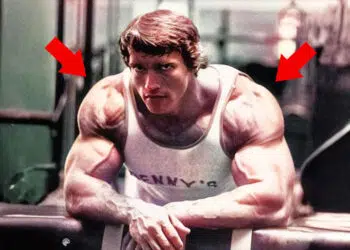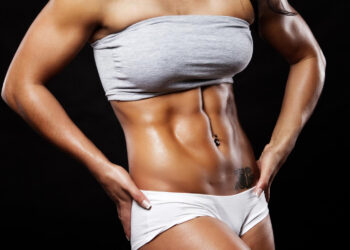When it comes to building strong shoulders, shapely triceps, and a chiseled core, most people treat these muscle groups differently. They may even train them separately. For example, they’ll do compound overhead presses for their shoulders, isolation triceps pushdowns for their arms, and planks and crunches for their core.
While such an approach is both conventional and effective, it’s not without drawbacks. For starters, your muscles rarely work alone, and most everyday and athletic movements involve your entire body.
Firstly, if you want strength that you can use out in the “real world,” your workouts need to replicate the activities you are likely to face. This is called functional strength training.
Secondly, training your body one part at a time is not very time-efficient. Lack of time is a common barrier to consistent exercise (1), so long or very frequent workouts can make exercise unappealing or difficult to schedule.
As a 30-year veteran personal trainer, I’ve helped thousands of people achieve their fitness and body composition goals. During that time, I’ve learned which exercises provide the biggest bang for your buck, delivering the best results in the least amount of time.
One of my favorite exercises is especially unique – the javelin press. In this article, I reveal how and why to do this exercise and provide you with several variations and alternatives to try.
Level Up Your Fitness: Join our 💪 strong community in Fitness Volt Newsletter. Get daily inspiration, expert-backed workouts, nutrition tips, the latest in strength sports, and the support you need to reach your goals. Subscribe for free!
Javelin Press Correct Form
The javelin press is considerably more challenging than the conventional overhead press. However, given its advantages and benefits, it’s worth investing a little extra time to learn this new movement.
Follow these steps to become a javelin press master!
- Place a barbell in a squat rack set to about shoulder height. Do not load the barbell initially; the empty bar will probably be heavy enough.
- Stand side-on to the barbell and grip the center with a neutral (palms facing you) grip.
- Brace your core.
- Unrack the barbell and take one small step away from the rack. Stand with your feet shoulder-width apart, knees slightly bent for stability.
- Your forearm should be vertical and close to your side – tuck your elbow in.
- Extend your non-working arm out to the side for balance if required.
- Make sure your hips and shoulders are perfectly level.
- Without leaning sideways or using your legs, smoothly press the barbell up and overhead to arm’s length.
- Lower the bar back to your shoulder and repeat.
- Rerack the barbell, turn around, and do the same number of reps with the opposite arm.
Javelin Press: Muscles Worked
The javelin press is essentially a shoulder exercise. However, the shoulders are made up of several muscles, and your core also gets in on the action. Consequently, the javelin press hits quite a long list of important muscles, and the main ones are:
- Anterior (front) deltoid
- Medial (side/middle) deltoid
- Posterior (rear) deltoid
- Rotator cuff
- Triceps brachii
- Forearms
- Obliques
- Rectus abdominus
- Erector spinae
- Transverse abdominis
With so many muscles involved, it’s no wonder that the javelin press is near the top of my list of must-do functional strength exercises!
Pro-Trainer Tips
Get more from the javelin press with these tried-and-tested pro-trainer tips.
Brace your core – while the javelin press is a shoulder exercise, each rep will also challenge your core. Brace tightly to ensure your torso remains upright. This means tensing your abs, pulling up your pelvic floor, and inhaling into your abdomen to increase intra-abdominal pressure (IAP). Once braced your midsection and spine should feel solid and stable.
Use a mirror – it can be hard to tell if you are leaning or twisting during this exercise, so do it in front of a mirror to check your form. Being unable to stay upright suggests that you are not fully engaging your core, or the weight is too heavy.
Grip the bar tightly – a tight grip will help you balance the weight and fire up your wrist, elbow, and shoulder stabilizers. Long Olympic bars are inherently unstable, so you’ll probably appreciate anything that helps prevent unnecessary wobbling.
Start light – a standard Olympic barbell weighs 45lbs/20kg, which is a significant amount of weight. In addition, the length of the bar makes that weight less stable, so it’ll feel heavier. Err on the side of caution by not adding any extra plates until you are confident you have mastered the exercise. Some people may need to use a lighter, non-standard barbell.
Do the same number of reps on both arms – while it’s normal to have one arm stronger than the other, large strength imbalances can cause postural, functional, and performance issues, often leading to injuries.
Avoid making any imbalances worse by always doing the same number of reps with both arms. Lead with your weaker arm and match the reps performed with your stronger arm if you have a noticeable left-to-right discrepancy.
Javelin Press Mistakes to Avoid
Make the javelin pressas safe as possible by avoiding these common mistakes.
Setting the Initial Bar Height Too High or Too Low
Javelin presses are hard enough without making it difficult to unrack the bar. Place it too low and you’ll need to bend your knees more than is ideal. Set it too high, and you’ll find yourself on tiptoes. Avoid both these scenarios by positioning the bar so it’s level with the center of your shoulder and, therefore, easy to unrack.
Leaning to The Side
Whether you lean toward or away from the weight, not keeping your torso perfectly upright means you are doing the javelin press incorrectly. Keep your core locked down and your hips and shoulders level to make this exercise as safe and effective as possible. Use a mirror or video yourself to confirm you aren’t leaning sideways.
Level Up Your Fitness: Join our 💪 strong community in Fitness Volt Newsletter. Get daily inspiration, expert-backed workouts, nutrition tips, the latest in strength sports, and the support you need to reach your goals. Subscribe for free!
Lifting or Lowering the Weight Too Fast
While lifting explosively has its place, the javelin press works best when you use a slower, smoother tempo. This will help keep the bar balanced and reduce the chances that you’ll lean sideways or twist. A 2:2 tempo (two-second lifting and two-second lowering) works well with javelin presses, but you can go slower if you wish, e.g., 3:3 or 4:4.
Using Your Legs
The push-press and jerk are legitimate strength training exercises that involve driving with your legs to lift the weight during overhead presses. However, using your legs during the javelin press suggests you are using too much weight. Keep your knees slightly bent but rigid throughout your set and reduce the load if you still need to use your legs.
Going Too Heavy Too Soon
Most javelin pressing faults occur because the lifter is trying to use too much weight. There is not much margin for error with this exercise, and even a few too many pounds can be the difference between success and failure. For that reason, I strongly suggest starting light and increasing the weight slowly using small-denomination weight plates or microplates.
Javelin Press Benefits
Not sure if the javelin press deserves a place in your workouts? Consider these benefits and then decide.
Bigger, Stronger Shoulders
Like all overhead pressing exercises, the javelin press is a great way to develop shoulder size and strength. According to fitness expert Jeff Nippard, overhead pressing is one of the best ways to build “cannonball delts.” In addition, overhead presses are a great way to beef up your triceps.
Increased Balance and Stability
You don’t need to stand on a wobbleboard or BOSU to improve your balance and stability; lifting a seven-foot barbell with one hand will challenge both of these characteristics. In fact, for most people, learning to control the bar is the most challenging part of mastering the javelin press.
Improved Shoulder Health
Shoulder pain is a problem for many exercisers. The shoulder joint is involved in most upper body exercises, and pain in this region can undermine all your workouts. The javelin press forces to you use lighter loads and work on your balance and stability, all of which can contribute to short and long-term improvements in shoulder health.
Saves You Time
Struggling to find the time to train your shoulders AND your core? There is no need to miss out; do the javelin press and train your delts and abs together! The javelin press is one of my favorite time-saving exercises.
A Functional Exercise
Lifting heavy objects above your head is a common challenge for many people. This often involves using just one arm, e.g., putting a can of paint on a shelf in your garage. The javelin press replicates the demands of this type of movement, making it a truly functional exercise.
Variety and Fun
Overhead presses are part of most people’s workouts. However, conventional presses can become boring if you do them all the time. Add some variety to your workouts with the javelin press, an exercise that can also be described as unique and fun.
Javelin Press Variations and Alternatives
As good as the javelin press is, you don’t need to do it all the time to build the shoulders of your dreams. Here are a few variations and alternatives you can use to ensure your upper body workouts are never repetitive or boring.
Smith Machine Javelin Press
Do you want to try the javelin press but are worried about losing control of the barbell? Avoid this problem while still enjoying many of the benefits with Smith machine javelin presses. While they won’t improve your balance and stability as much, you’ll still get a great shoulder, triceps, and core workout. Note: taller lifers may need to do this exercise seated.
Dumbbell Javelin Press
Beginners often find balancing a barbell with one arm very challenging. After all, that seven-foot bar tends to turn and tilt if you aren’t “locked in.” The good news is that you can get many of the benefits of the javelin press by using a dumbbell instead of a barbell. Develop your basic strength and then progress to the barbell version when you are ready.
Bent Press
The bent press is a classic old-school barbell exercise. As the name suggests, it involves pressing a weight overhead as you lean to the side. Like the javelin press, the bent press trains your shoulders, triceps, and core. Learn how to do the bent press in this in-depth guide.
Single-Arm Push-Press
The javelin press is best done using a slow, smooth lifting and lowering technique. Trying to raise and lower an Olympic bar too quickly will invariably unbalance it. However, fast lifting increases muscle engagement. Switch to a dumbbell, add a little leg drive, and you’ve got the perfect unilateral upper body power pressing exercise that also works your core.
Single-Arm Dumbbell Clean and Press
One of the drawbacks of many overhead pressing exercises is lifting the weight to your shoulders so you can start your set. That’s why a lot of lifters use machines or begin with a barbell in a squat rack. Get around this issue by cleaning your dumbbell from the floor to your shoulders. In fact, this is such a great movement that it’s worth making it part of your workout by doing single-arm dumbbell clean and presses.
Closing Thoughts
You won’t see many people doing the javelin press – it’s an old-school shoulder exercise that most trainers have forgotten about. However, despite being a little unusual and old-fashioned, the javelin press has the power to transform your upper body, sculpting your shoulders and strengthening your core.
Most lifters find the javelin press far harder than conventional overhead presses, complaining that they cannot balance the bar or stop it twisting. But, it’s the battle to control the weight that makes this exercise so darn effective!
So, check your ego, lighten the load, and try the javelin press. Not only will you build muscle and strength, but you’ll also improve your balance and stability, making regular overhead presses feel easy by comparison.
References:
- Herazo-Beltrán Y, Pinillos Y, Vidarte J, Crissien E, Suarez D, García R. Predictors of perceived barriers to physical activity in the general adult population: a cross-sectional study. Braz J Phys Ther. 2017 Jan-Feb;21(1):44-50. doi: 10.1016/j.bjpt.2016.04.003. Epub 2017 Jan 14. PMID: 28442074; PMCID: PMC5537451.
Interested in measuring your progress? Check out our strength standards for Clean and Press, Push Press, Clean, and more.








